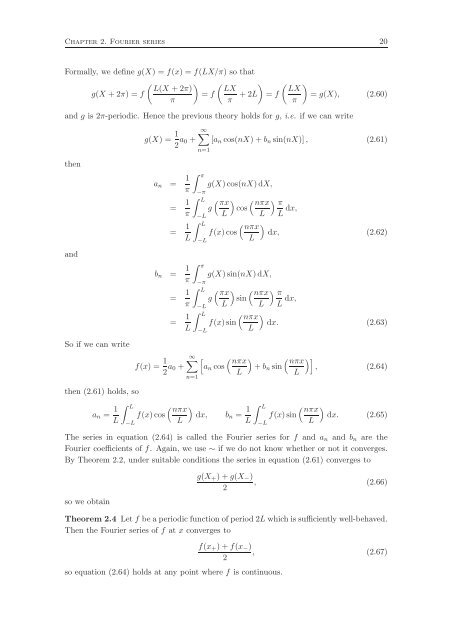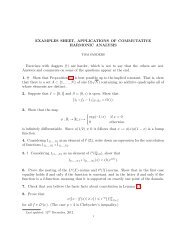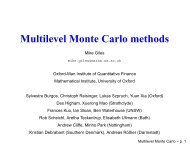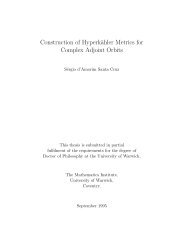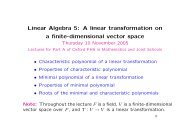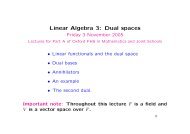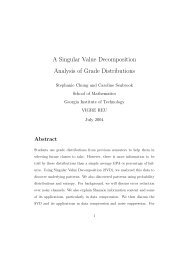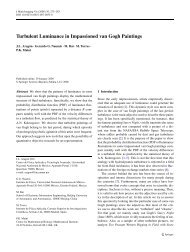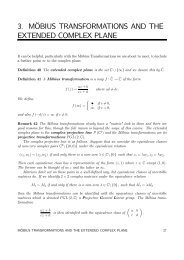Fourier Series and Partial Differential Equations Lecture Notes
Fourier Series and Partial Differential Equations Lecture Notes
Fourier Series and Partial Differential Equations Lecture Notes
Create successful ePaper yourself
Turn your PDF publications into a flip-book with our unique Google optimized e-Paper software.
Chapter 2. <strong>Fourier</strong> series 20<br />
Formally, we define g(X) = f(x) = f(LX/π) so that<br />
<br />
L(X +2π) LX<br />
g(X +2π) = f = f<br />
π π +2L<br />
<br />
= f<br />
<br />
LX<br />
= g(X), (2.60)<br />
π<br />
<strong>and</strong> g is 2π-periodic. Hence the previous theory holds for g, i.e. if we can write<br />
then<br />
<strong>and</strong><br />
So if we can write<br />
then (2.61) holds, so<br />
g(X) = 1<br />
2 a0 +<br />
∞<br />
[ancos(nX)+bnsin(nX)], (2.61)<br />
n=1<br />
an = 1<br />
π<br />
π<br />
= 1<br />
π<br />
−π<br />
g(X)cos(nX)dX,<br />
L <br />
πx<br />
<br />
nπx<br />
<br />
π<br />
g cos<br />
−L L L L dx,<br />
= 1<br />
L <br />
nπx<br />
<br />
f(x)cos dx, (2.62)<br />
L L<br />
−L<br />
bn = 1<br />
π<br />
g(X)sin(nX)dX,<br />
π −π<br />
= 1<br />
L <br />
πx<br />
<br />
nπx<br />
<br />
π<br />
g sin<br />
π −L L L L dx,<br />
= 1<br />
L <br />
nπx<br />
<br />
f(x)sin dx. (2.63)<br />
L L<br />
f(x) = 1<br />
2 a0 +<br />
an = 1<br />
L<br />
f(x)cos<br />
L −L<br />
∞<br />
n=1<br />
−L<br />
<br />
ancos<br />
<br />
nπx<br />
<br />
+bnsin<br />
L<br />
<br />
nπx<br />
<br />
dx, bn =<br />
L<br />
1<br />
L<br />
f(x)sin<br />
L −L<br />
<br />
nπx<br />
<br />
, (2.64)<br />
L<br />
<br />
nπx<br />
<br />
dx. (2.65)<br />
L<br />
The series in equation (2.64) is called the <strong>Fourier</strong> series for f <strong>and</strong> an <strong>and</strong> bn are the<br />
<strong>Fourier</strong> coefficients of f. Again, we use ∼ if we do not know whether or not it converges.<br />
By Theorem 2.2, under suitable conditions the series in equation (2.61) converges to<br />
so we obtain<br />
g(X+)+g(X−)<br />
, (2.66)<br />
2<br />
Theorem 2.4 Let f beaperiodicfunction of period2L which is sufficiently well-behaved.<br />
Then the <strong>Fourier</strong> series of f at x converges to<br />
so equation (2.64) holds at any point where f is continuous.<br />
f(x+)+f(x−)<br />
, (2.67)<br />
2


